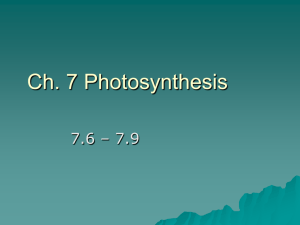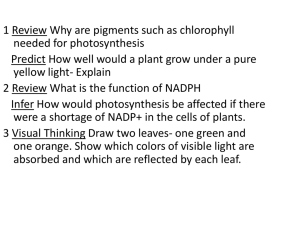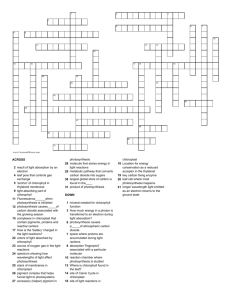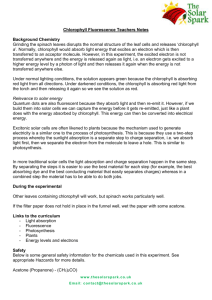Photosynthesis - The Light Reaction
advertisement
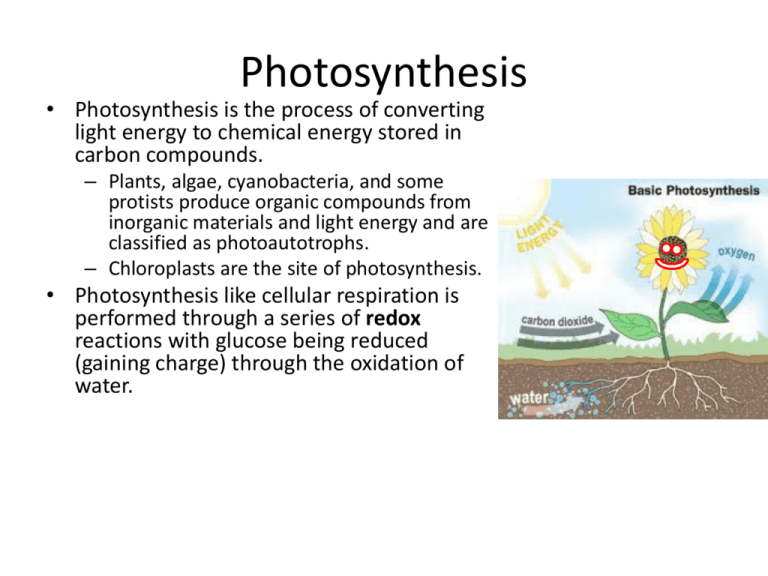
Photosynthesis • Photosynthesis is the process of converting light energy to chemical energy stored in carbon compounds. – Plants, algae, cyanobacteria, and some protists produce organic compounds from inorganic materials and light energy and are classified as photoautotrophs. – Chloroplasts are the site of photosynthesis. • Photosynthesis like cellular respiration is performed through a series of redox reactions with glucose being reduced (gaining charge) through the oxidation of water. Chemical Equation • 6CO2 + 12H2O + light energy g C6H12O6 + 6 O2 + 6H2O • 6CO2 + 6H2O + light energy g C6H12O6 + 6 O2 (simplified formula) – CO2 + H2O g [CH2O]n + O2 (reduced formula) • the reduced formula is necessary to visualize that the sugar molecule is built one carbon at a time – Production of O2 is from the splitting of water (not CO2) • confirmed by C.B. van Neil using the isotope O-18 – Carbon in the glucose comes from CO2 – Hydrogen in the new water and in the water come from reactant water – Oxygen in the glucose and the new water come from the CO2 in the reactants • Chloroplasts - site of photosynthesis – primary pigment is chlorophyll (green) • found in the mesophyll - tissue of the leaf's interior – contains 30-40 chloroplasts – stroma - fluid filled compartment surrounded be 2 membranes – thalakoids - stack of membraneous sacs that separate the stroma from other compartments (place where chlorophyll resides) – grana - stack of thalakoids • CO2 enters through holes in the leaf's surface called stomata • veins carry water to the leaves and export sugar to various parts Structures • The light reaction of photosynthesis takes advantage of the photoelectric effect (ability of photons to exert inertia on electrons) and the photosynthetic pigment chlorophyll. There are 3 main pigments (2 types of chlorophyll) used in plants. The action spectrum describes which wavelength of light works best for each (studied by looking at CO2 uptake and O2 production). – Chlorophyll a • blue-green in color • absorbs violet and red best • reflects blue & green – Chlorophyll b • yellow-green in color • absorbs blue and red best • reflects yellow & green – Carotenoids • various shades of red, orange, and yellow • called accessory pigments • absorbs violet & blue-green The Light Reaction • Photosystems – light harvesting complex containing the pigments where light energy is harvested – When a photon is absorbed by a pigment it causes an e- to move from its ground state to an excited state. • The electron (because it is unstable in its new configuration) immediately returns to its ground state releasing the stored energy. – photon energy is transferred from pigment to pigment until it reaches the reaction center – The energy is then harvested where it is transferred to an electron acceptor. NADP+ • the reaction center is composed of a chlorophyll a molecule & a primary electron acceptor – chlorophyll a boosts its e- to an excited state where it is oxidized as the primary electron acceptor removes it – this is the 1st step in changing light energy to chemical energy (glucose) Photosystems • • • • The thylakoid membranes are populated by two types of photosystems (PS I & PS II). The two work together to produce ATP & NADPH (8 steps in the non-cyclic flow of electrons) A photon strikes a pigment in PS II & is transferred until in reaches P680 in the reaction center. The excited electron is captured by an electron acceptor. Water is split – – – • The excited e- is passed through an electron transport chain (ETC) to PS I – • • plastoquinine (Pq) g cytochrome complex g plastocyanin (Pc) The exergonic "fall" of electrons provides energy for the synthesis of ATP (via proton-motive force & ATP synthase) PS I absorbs a photon and donates an e- from P700 to its electron acceptor – • • 2 H+ are produced (reduced) 2 e- are given back to the P680 O2 is produced from the oxidized O 2 electrons from PS II fill in the space (electron hole) Electrons captured by P700 are transfered down a 2nd ETC through the protein ferredoxin (Fd) Enzyme NADP+ reductase transfers the 2 e- to NADP+ to NADPH (requires 2 e-) – NADPH is then transferred to the Calvin Cycle • Occasionally the system may skip PSII and operate under cyclic flow. In cyclic flow, ATP is generated but no NADPH is produced for transfer into the Calvin Cycle


